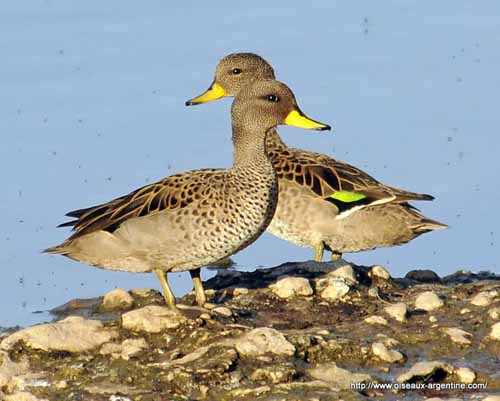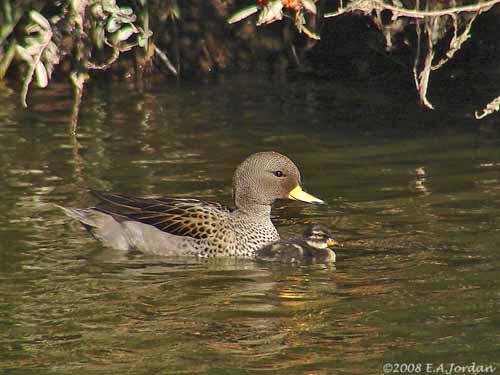
Fr: Sarcelle tachetée
Ang: Yellow-billed Teal, Speckled Teal, Chilean teal, South American Teal, Speckled Duck
All: Chile-Krickente
Esp: Cerceta barcina, Cerceta del Chile, Pato barcino, Pato jergón, Pato jergón chico, Pato Paramuno
Ita: Alzavola macchiettata
Nd: Chileense Taling
Sd: Gulnäbbad kricka
Port: marreca-pardinha
Photographers:
John Anderson
John Anderson Photo Galleries
Eduardo Andrés Jordan
MIS AVES – AVES DE ARGENTINA
Otto Plantema
Trips around the world
Philippe et Aline Wolfer
OISEAUX D'ARGENTINE
Text by Nicole Bouglouan
Sources:
HANDBOOK OF THE BIRDS OF THE WORLD vol 1 by Josep del Hoyo-Andrew Elliot-Jordi Sargatal - Lynx Edicions - ISBN: 8487334105
GUIDE DES CANARDS, DES OIES ET DES CYGNES – de Steve Madge - Delachaux et Niestlé - ISBN: 2603013769
BirdLife International (BirdLife International)
Animal Diversity Web (University of Michigan Museum of Zoology)
Breeding of Speckled Teal on South Georgia
Yellow-billed Teal or Speckled Teal
Anas flavirostris
Anseriformes Order – Anatidae Family
INTRODUCTION:
The Yellow-billed Teal is a common South American duck. We can find two groups, each one with two subspecies.
The first group with A.f. flavirostris and A.f. oxyptera is found in S South America and in the Falklands. There is a small isolated population in South Georgia Island too. This group is studied on this page.
The second group with A.f. andium and A.f. altipetens occurs from C Andes of Colombia to N Ecuador. This group is now considered a full species and named Andean Teal (Anas andium). This group will be studied later.
DESCRIPTION OF THE BIRD:
Biometrics:
Length: 35-45 cm
Weight: 600-830 g
The adult has brownish plumage overall. The upperparts are dark grey-brown with paler feather edges. On the upperwing, the coverts are greyish-brown and the greater coverts are broadly tipped yellowish. The secondaries are glossy green with whitish edges. The speculum is black and green, bordered with pale chestnut on one side, and with white on the trailing edge. The green part is mainly visible in flight. The short tail is pale grey-brown.

The underparts are pale brownish-grey, but the breast is densely speckled blackish. The underwing is dark grey-brown with median whitish band. Flanks and belly are paler with few markings.
Head and neck are greyish-brown with dark tiny speckles.
The bill is yellow with black culmen, tomium and nail. The eyes are brown. Legs and webbed feet are dark grey.

The Yellow-billed Teal is very similar to the Yellow-billed Pintail, but it has shorter tail and neck, and more rapid flight. In addition, the Yellow-billed Pintail does not form flocks.
The female has similar plumage but duller, with darker head and duller yellow bill. She is slightly smaller than male.
The juvenile resembles adults with less distinct breast pattern.
SUBSPECIES AND RANGE:
The nominate race A.f. flavirostris (here described and displayed) is found in N Argentina to Tierra del Fuego, the Falklands and South Georgia (since 1971).
The race A.f. oxyptera occurs in the Andes of Central Peru to N Chile and NW Argentina. This one has much paler underparts with dark markings only on breast sides. The head is dark brown with duller yellow bill.

HABITAT:
The Yellow-billed Teal “flavirostris” breeds at high elevation near freshwater lakes and marshes, but also in coastal lagoons and estuaries in open areas, from sea-level to high mountains. During winter, it can be seen along the coasts in brackish and marine wetlands.
In the Falklands, it frequents ponds, streams and creeks.
In South Georgia, it is restricted to the deep and permanent glacial ponds in the Moraine Fjord area.
The race “oxyptera” is also found at high elevation, but it breeds mostly from valleys to the Chilean coastline.

CALLS AND SONGS: SOUNDS BY XENO-CANTO
The Yellow-billed Teal gives series of calls during the courtship displays. The male utters a melodious “prip” and the female produces a “quack”.
BEHAVIOUR IN THE WILD:
The Yellow-billed Teal feeds on a variety of food items such as aquatic invertebrates, and especially amphipods and molluscs. During winter, it may feed on rotting kelp and seeds along the shore.
In the Falklands, it feeds on aquatic invertebrates and vegetation.
In South Georgia, it feeds mainly on crustaceans such as Cyclops, and fine vegetable matter.
The Yellow-billed Teal feeds by dabbling and walking in shallow water, or by swimming while grabbing preys from the surface.

They can form flocks of 10-20 individuals, and sometimes up to 200 birds.
Male and female remain together during winter, and greeting displays occur regularly when both sexes are present. They are monogamous.
During displays, both mates take part in courtship. The female incites the male by giving series of 5-12 notes. The male performs greeting displays with wide open bill and neck stretched forwards. Prior to copulation, both sexes perform mutual head-pumping. The post-copulation display is performed by the male which flings the head back while uttering whistles.


Competition for nesting sites is intense with the Monk Parakeet (Myiopsitta monachus), as the teal tries to nest in the nest-chamber inside the huge nest of this Psittacidae.
The Yellow-billed Teal is mainly sedentary in its range, including in the Falklands and South Georgia. However, the southernmost populations move to more temperate regions during winter. They can reach Uruguay, Paraguay and SE Brazil.
They fly fast and well.


REPRODUCTION OF THIS SPECIES:
The breeding season varies according to the range.
The race “oxyptera” breeds in November-December, usually sooner in Chile, mostly late August and September.
The nominate race “flavirostris” breeds from October to November. In the Falklands, the season starts in August, with 5-8 eggs in grass nest close to the water. In South Georgia, downy chicks have been observed in early December.

The Yellow-billed Teal may nest on the ground or higher above the ground. This species tends to nest in high tree cavities or arboreal sites, and even in a part of the huge nest of the Monk Parakeet. But the nest can also be built on the ground, near water and vegetation. The female usually builds a half moon-shaped nest.

She lays 5-12 eggs, and incubates during 24 days. The chicks are able to go to the water within 24 hours after hatching, and they can feed themselves. Usually, male and female care and protect them. They fledge about 42 to 49 days after hatching.
This species produces a single clutch, but locally, a second brood can be laid.

PROTECTION / THREATS / STATUS:
The Yellow-billed Teal is vulnerable to predation while nesting on the ground, and to hunting by humans.
The population of the race “flavirostris” is estimated at about 1,000,000 birds on the South American continent, and about 25,000/100,000 birds of race “oxyptera”.
The Falkland’s population is about 18,000/33,000 birds (1983-1993).
In South Georgia, the population was estimated at 40/50 birds in Cumberland East Bay in 1971-1972.
But currently, the Yellow-billed Teal is not threatened and evaluated as Least Concern.

